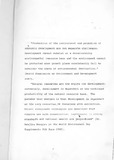| dc.description.abstract | In the semi -arid and arid lands in Kenya, great structural changes have taken place and are still taking place in regard to agricultural development. This has been brought about by the progressive expansion of agricultural activities coupled with sedentarisation in these marginal environments. Marginal environments are fragile and less resilient to the effects of man and his concomitant labour activities. In this context, the study is based on the themeof conservation of marginal agricultural environments by use of the concept of environmental threshold approach in agricultural land-use planning. From the onset, the study is a scientific experimental effort to attempt prior application of the approach for the purposes of planning and policy development fcr sustainable agricutural development in marginal areas in Kenya.
From the above context, the study has used the concept of enviromental threshold for an attempt to comprehensively perceive the spatial variation of environmental thresholds in Ng'arua Division. This was aimed in establishing the environmental thresholds in the area and policies designed to mitigate overstepping of environmental threshold were drawn.
To achieve the above goals, the study aimed at identifying various agricultural land use types and assess the environmental thresholds spatially in the context of the identified agricultural land use types. For this purpose delienation of agricultural land use types and environmental threshold is done resulting to thematic maps of the above considerations.
Survey and study of the resource base of the Division was done to assess the area's resource potential and sensitivity of the ecosystems to man's labour activities. Soil and climate are the major parameters that were used. However, the systems of environmental exploitation and management are studied to help in assessment of environmental trends and situation. Negative environmental consequences are used as manifestations of overstepping of the environmental threshold.
The analyses reveals that environmental threshold studies is a useful tool in guiding the description of the environmental situation of the marginal agricultural land so long as it is not assigned permanent value because *of the dynamic nature of the agricultural process. It is evident from this study that the approach is important in the overall agricultural land-use planning process and decision making for the settled and unsettled marginal environments.
In a nutshell, the study has revealed that environmental threshold approach in agricultural land-use planning can be used as an instrument for policy development prior to the use of other instruments of policy implementation and evaluation. In this respect, sustainable agricultural development and conservation of the arid and semi-arid environments can be achieved by use of the environmental threshold approach in agricultural land-use planning. | |

